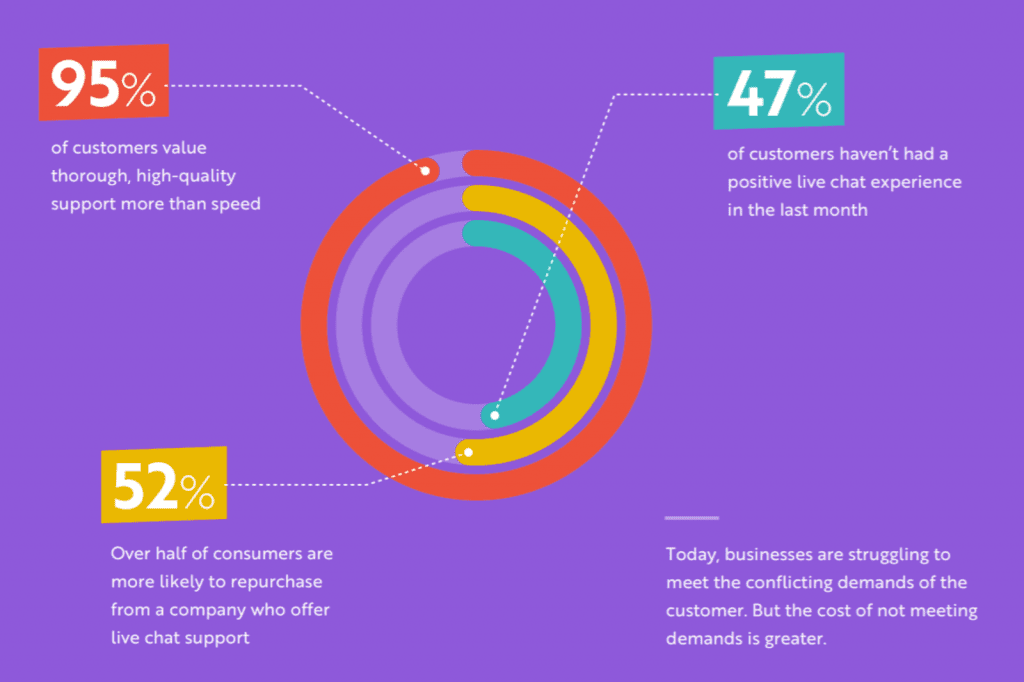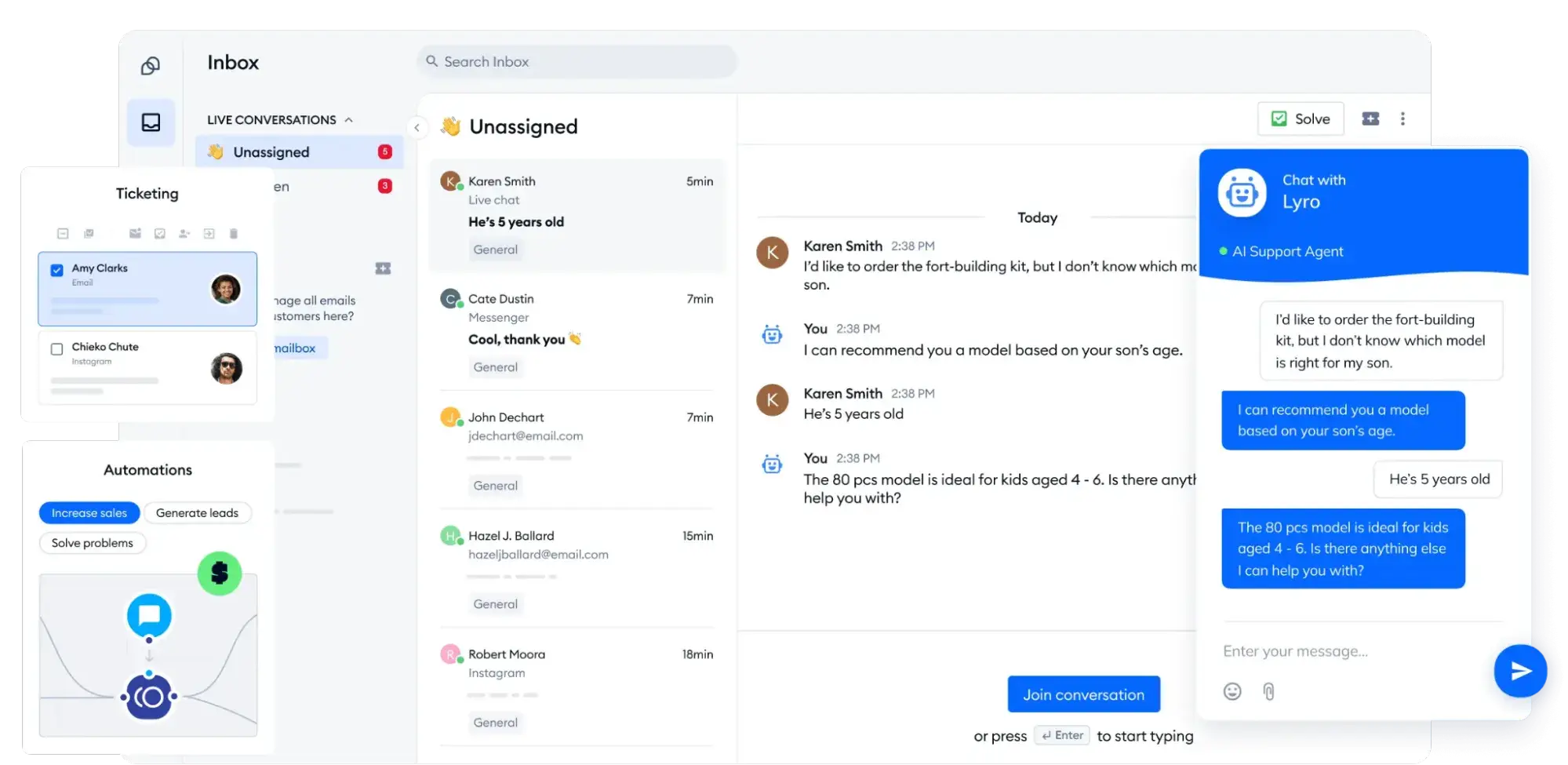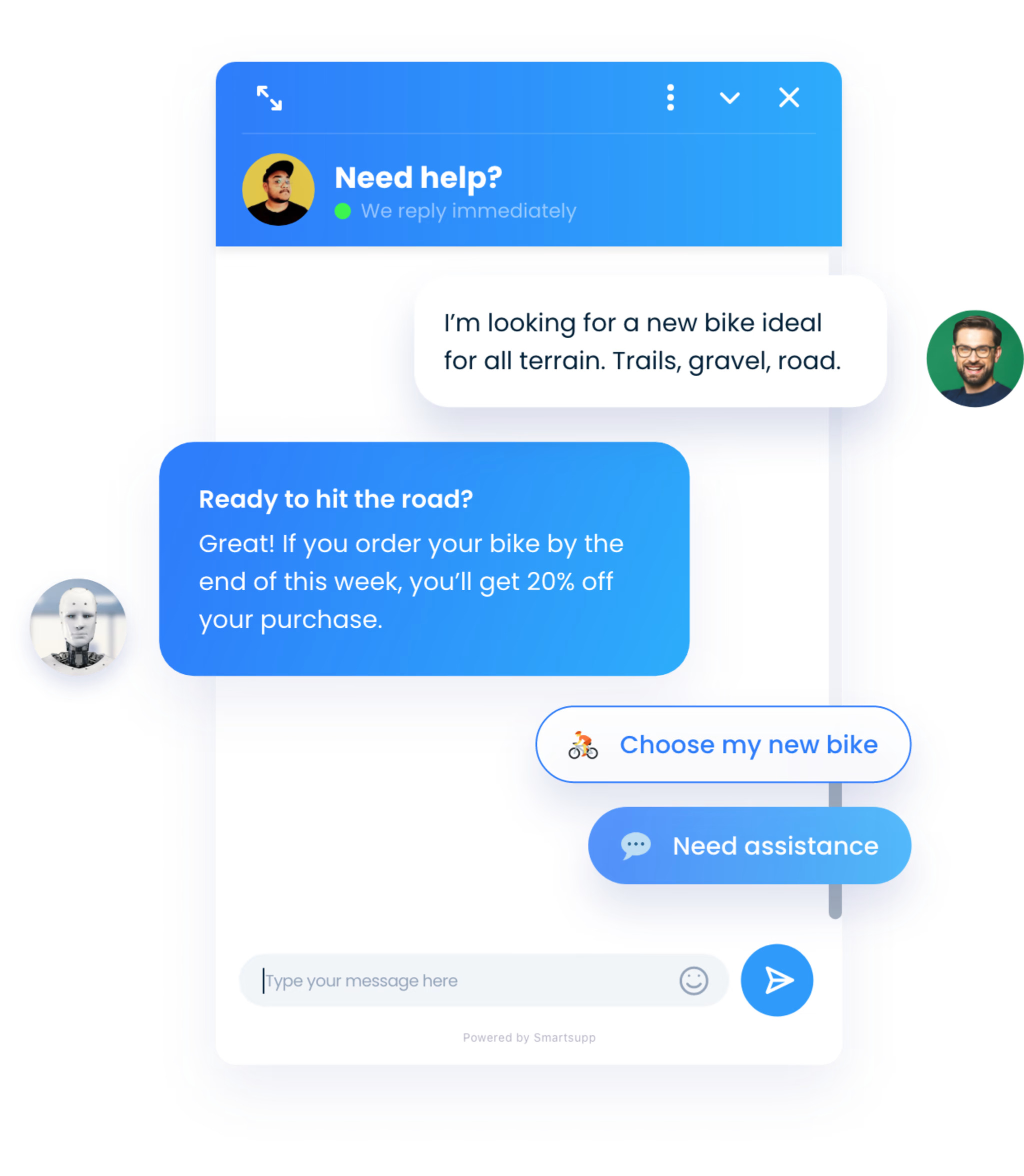Table of contents
But more than that causes a blunder as the live chats are expected to respond within 45 seconds. Reduced response quality, increased stress, delayed solutions, and mixed-up conversations—are all challenges operators face while handling multiple chats manually.
An efficient chat support streamlines multiple conversations, reduces response time, and fosters a positive customer experience, allowing customer support executives to multitask.
This article guides you through practical strategies for handling multiple live chats and shows how to leverage AI for efficient chat support.
1) Prioritization: Knowing Which Chats to Handle First
When handling multiple live chats, it is important to determine the urgency level of queries.

Prioritization ensures that customers are addressed timely without any delay. This shows your commitment to building a reliable chat support system. For example, a query from a long-term customer might be of more importance than a new visitor with a general inquiry.
The following strategies help you identify which chats to handle first:
Value of customer
The value of a customer increases when they make repeat purchases. In fact, eCommerce businesses generate over 60% of revenue from repeat purchasers. So, it’s always beneficial to prioritize inquiry tickets raised by long-term customers and bulk purchasers. This leads to improved customer satisfaction and brand loyalty.
Triage by issue urgency
Not all queries require immediate attention. Urgent issues that affect purchases, payments, or account security should come first.
For example, if you run a SaaS company, and you receive three live chat messages:
- Chat 1: A free trial user asking about upgrading.
- Chat 2: A customer unable to log in due to a system error.
- Chat 3: A potential customer asking about pricing.
Here, Chat 2 is the top priority because it affects the user’s ability to access their account, followed by Chat 3 (a sales opportunity), and finally Chat 1 (which can wait a few minutes).
Setting escalation rules for complex cases
This refers to setting up a seamless process of transferring customer queries to service experts for detailed assistance. Having clear rules on when and how to escalate helps simplify responses and prevents unnecessary delays.

Here’s when to escalate a chat:
- Technical escalations: If an issue requires backend access or developer intervention.
- Policy-related escalations: When a refund or compensation decision is beyond the agent’s authority.
- Legal or security concerns: Data breaches, fraudulent transactions, or identity verification issues.
Through escalation management, queries related to additional expertise, authorization, and SLA (Service Level Agreement) violations are automatically escalated to senior service agents.
Managing wait times effectively
Always determine the wait time beforehand. Set clear expectations through real-time updates and an inquiry ticket tracker.
Moreover, including self-service options like online portals to track orders and conduct balance inquiries improves customer experience by giving faster access to desired information. In fact, 67% of consumers prefer solving issues by themselves without speaking to any support executive according to study of Zendesk.
For example, Amazon offers a self-service portal to its customers to track orders, manage subscriptions, and monitor payments.
2) Speed vs. Quality: Balancing Response Time and Accuracy
Customers want quick responses but not at the cost of quality. Rushing through chats can cause blunders while operating too slowly can frustrate them—so how can you strike the right balance between speed and accuracy?

Striking the right balance between speed and accuracy
Speed and accuracy are two important components of proactive customer service. Businesses must adapt to technological advancements to meet the evolving customer’s expectations.
Maintain efficiency and response quality
Fast responses mean nothing if they lack clarity or accuracy. The best live chat teams train their agents to think on their feet while maintaining a high standard of support. Here’s how you can boost both efficiency and quality:
- Invest in quick problem-solving training – Regular, bite-sized workshops help agents master common issues, product details, and troubleshooting techniques. A well-trained agent can solve problems on the spot instead of escalating them unnecessarily.
- Use a structured ticketing system – Not all issues should be handled in the same way. A smart ticketing workflow automation ensures that problems are categorized and assigned to the right agent immediately. Here’s how it works:
- Each ticket is tagged under categories like Billing, Technical Issue, or General Inquiry.
- Based on priority, it is automatically routed to the right support agent.
- Agents with specialized expertise handle complex issues, reducing back-and-forth.

Clear messaging
Avoid technical jargon that might confuse customers. Communicate in a simple and concise manner while assisting customers. This boosts clarity which reduces back-and-forth messages from the customer.
You can also use pre-written templates for handling general inquiries, provided you modify them adhering to the customer’s feedback.
When agents optimize to-the-point responses, the issue gets resolved in the first interaction. Customers appreciate quick issue resolution as it saves time and effort on both ends.
Communication
Observe the customer’s tone and simplicity of their language in complaint tickets. For instance, if a customer is casual, respond casually. Similarly, if a customer is frustrated, acknowledge their concern with empathy.
This helps you communicate with them in a personalized tone, resulting in a deeper connection. This approach can result in higher customer satisfaction which motivates customers to recommend your brand to their friends and family. As a result, your business can get more leads and with the lead distribution software, it’s easy to convert them into customers.
3) Using AI and Automation to Stay Efficient
AI has fast-paced the customer service industry and reduced a significant amount of business operational costs. In addition, businesses can streamline their marketing efforts by implementing social media automation tools to efficiently manage and schedule content across various platforms.
73% of shoppers believe AI improves customer experience and increases conversion rates. But what is the role of AI and automation in customer service?

Automating repetitive tasks
AI chatbots automate repetitive queries like balance inquiries, order updates, and password resets with 24/7 chat support. This frees up the time for support staff to focus on more complex issues.
Smartsupp offers an AI chatbot that can engage with website visitors, answer frequently asked questions, and guide customers through their journey. This feature ensures that customers receive immediate assistance, enhancing their overall experience.

AI tools can automate data entry tasks, such as processing customer information or updating records. This reduces the chances of human error and ensures data accuracy. Smartsupp integrates seamlessly with various CRM systems, enabling automated data synchronization. This ensures that customer interactions are logged accurately without manual intervention.
Beyond chat automation, online businesses that operate on a subscription model can also leverage Smart SaaS subscription management solutions. These tools help streamline billing, automate renewals, and reduce churn by proactively addressing customer concerns before cancellations occur.
By integrating AI-driven subscription management with customer support, companies can enhance user retention while reducing manual intervention.
Enhanced personalization
AI uses machine learning and natural language processing to make conversations more human-like. It scans customer history and past interactions to send personalized messages to customers.
You can also use an AI voice generator to handle customer calls. AI replicates human speech patterns, creates lifelike voices, and speaks multiple languages to offer personalized support.
A leading brand example is Spotify which leverages AI-driven user data to create personalized playlists spotlighting their favorite artists. The app made personalization a trend with the introduction of the “Spotify Wrapped” feature. At the end of each year, users receive a summary of their listening habits mentioning the most played artist and genre.

This makes users feel very valued and delivers a satisfying experience.
Scaling customer support
AI handles routine tasks, reduces response times, and analyzes customer data using techniques like cross-tabulation analysis, allowing businesses to handle multiple queries at once. This is very useful when there is a sudden surge in inquiries. Providing real-time captions enhances accessibility and clarity in customer interactions. An online live caption tool ensures that every message is accurately transcribed, improving engagement and response accuracy.
For example: Mira AI, a smart shopping assistant developed by Smartsupp improves eCommerce operations by offering 24x7 assistance, handling up to 80% of customer inquiries. It plays a vital role in scaling customer support by offering multi-lingual assistance, escalating complex queries, recommending products, and sending custom replies. Additionally, tools offering Real-Time Agent Assist can further enhance efficiency by providing agents with instant suggestions and insights during live chats, ensuring high-quality responses even under pressure.
This reduces the workload on human agents, allowing them to handle complex issues requiring human intervention.
In conclusion, AI automation is beneficial but it doesn’t entirely replace human intervention. For instance;
- AI cannot handle complex queries.
- AI chatbots can sometimes experience downtimes and weak servers.
- Continuously being redirected to AI-generated FAQs and pre-written templates might frustrate users.
- Although machine learning enables AI to generate responses with a human touch, it cannot be as empathetic as a human in negative events.
Hence, even with AI chat support systems human intervention is still needed.
4) Mastering Keyboard Shortcuts and Predefined Responses
When handling multiple live chats, every second counts. Navigating through menus, doing right clicks, and switching between chats increases the time spent on resolving issues.
Use keyboard shortcuts instead to reduce the time spent on repetitive actions. Customer support agents can quickly switch between chats and tasks using hotkeys, leading to faster resolution with accuracy.
Some common shortcuts in customer service include:
- New Ticket – Ctrl + Alt + N
- Next Ticket – Ctrl + Alt + K
- Previous Ticket – Ctrl + Alt + J
- Update as Open – Ctrl + Alt + O
- Update as Pending – Ctrl + Alt + P
- Update as Solved – Ctrl + Alt + S
- Update As On hold – Ctrl + Alt + D
- End Chat – Shift + Escape
- Join Chat – Ctrl + Shift + J
- Leave Chat – Ctrl + Shift + K
- Transfer Chat – Ctrl + Shift + X
- Add Attachment – Ctrl + Shift + U
- Resolve Ticket – Ctrl + E
By using keyboard shortcuts, support agents can navigate between chats, update tickets, and perform actions instantly, improving both speed and accuracy.
Predefined (canned) responses take it a step further—allowing agents to respond instantly to common queries without typing everything from scratch.
Canned responses are pre-written responses crafted to address general inquiries.
Best practices for using canned responses
A) Personalized response
Personalization contributes up to 40% of revenue for businesses. To personalize responses, mention the customer’s name, ticket ID, and the specific issue for which the canned response is sent. Also, depending on the customer’s situation, tweak the pre-written message to give a personal touch.
Here’s an example:
Generic canned response: “We are processing your request. Please wait.”
Personalized version: “Hey [Sarah], I see that your order #1245 is on its way! You can track it [here]. Let me know if you need anything else.”
B) Ensure conversational tone
Avoid using technical jargon to overwhelm the customer, rather use a clear and conversational tone to address queries. Ensure that your response keeps the brand voice intact.
C) Segmentation
Tag the canned responses as per the type of query. Group responses based on:
- Urgency (e.g., billing issues vs. general inquiries)
- Topic (e.g., account setup, refunds, troubleshooting)
- Customer Type (e.g., new users vs. loyal customers)
Now, depending on the inquiry, support staff and automated systems can quickly access responses during live interactions.
D) Regular updates
Always modify the pre-written message based on customer feedback, product updates, and new policies. For businesses selling dropshipping products, keeping responses up-to-date ensures accurate information and a better customer experience. This is necessary because sending outdated response templates shows unprofessionalism and harms the brand’s reputation.
The aim is to keep responses relevant and easy to understand, allowing customers to explore available solutions.
However, dealing with customers can become monotonous and drain the energy of support executives, causing burnout. It is important to have enough breaks and a realistic workload.
5) The Importance of Breaks and How to Stay Focused
Customer support executives handle multiple chats, complaints, and queries daily. While efficiency is crucial, mental and physical well-being should not take a backseat. A healthy work environment leads to better service, increased job satisfaction, and higher retention rates. Let’s explore why breaks matter and how agents can stay focused.

🩵 Improves mental and physical well-being
Taking breaks in short intervals does not overwhelm the representative with the workload. Breaks alleviate stress, improve emotional health, and prevent burnout which is common in customer service roles.
Moreover, taking breaks also eliminates back pain caused due to prolonged sitting.
💪🏻 Improves productivity
Working continuously for long hours can increase the chances of human errors. Structured breaks reset the mental energy and help support executives to be creative and energetic in their approach.
♻️High retention rates
When customers are attended with a calm mind and positive energy, retention rates are likely to increase. Businesses must prioritize empowering service agents with appropriate training and tools.
Time management is another important factor in customer service. When tasks are handled strategically, a distraction-free workspace is built preventing cognitive overload.
You can implement the following time management techniques to stay focused and efficient:
- Pomodoro technique. This technique focuses on working in fixed intervals of 25 minutes (Pomodoros) followed by a 5-minute break. After completing 4 Pomodoros, a long break of 15-30 minutes is taken.
- Time blocking. Divide the day into specific time blocks for handling different tasks. These tasks can include replying to emails, solving complex queries, and responding to chats.
- Set SMART goals. Use specific, measurable, achievable, relevant, and time-bound goals. By implementing this daily, service agents can gain clarity about daily and weekly performance.
Mastering Multitasking in Customer Service
Handling multiple live chats is not an easy task. Customer service operatives must master multitasking to manage distinct tasks efficiently.
Customer service can become frustrating when not managed strategically, but with the right tools and approach, it can be effortless.
Use AI-driven tools, keyboard shortcuts, and canned responses to offer faster resolution. Also, invest in customer support to hire experts to handle complex queries.


